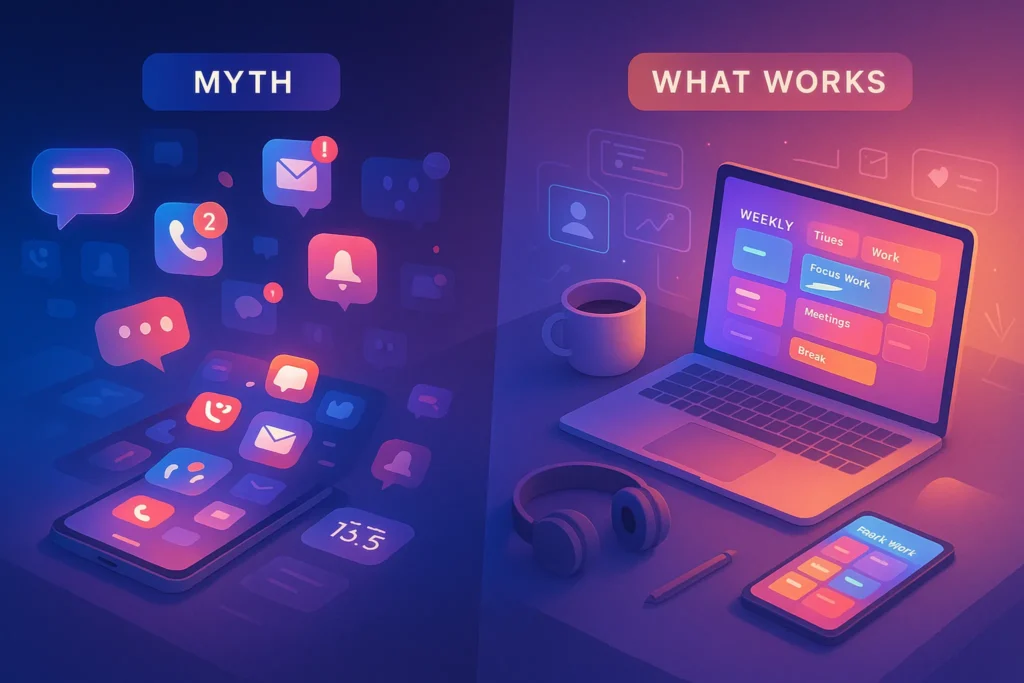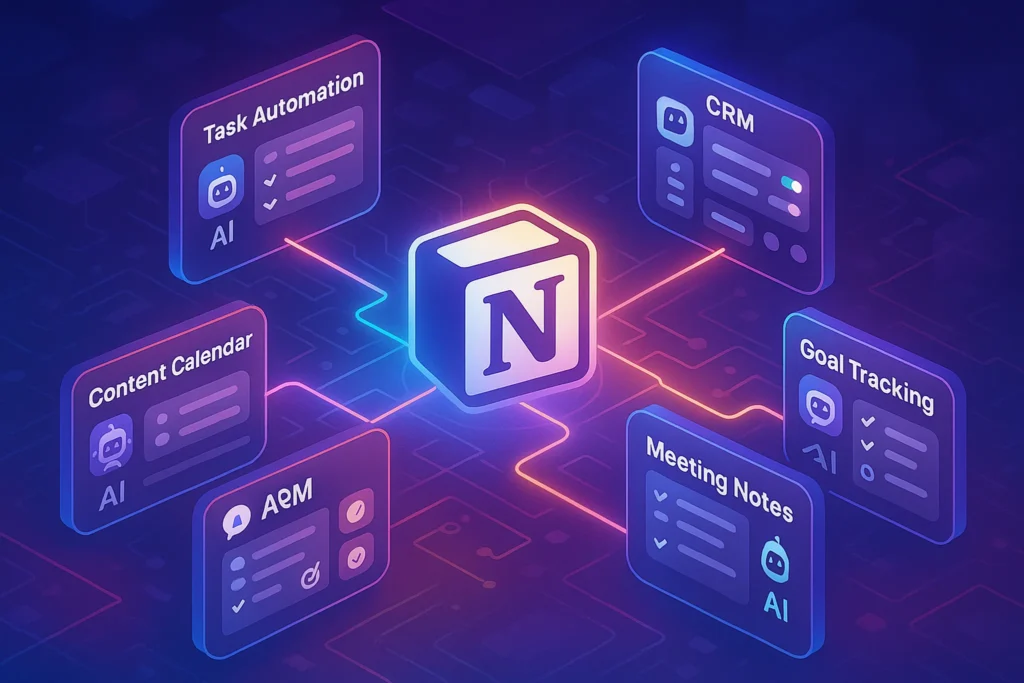-This post may contain affiliate links. If you click on one and make a purchase, I may earn a small commission at no extra cost to you.-
🧭 Introduction
When we chase productivity, we often grab for shiny myths: “Multitasking boosts output,” “Stay late and grind.” But most of those beliefs are false—and harmful. In this guide, we debunk five major productivity myths, replace them with evidence-based practices, and show how to build a sustainable work routine. Building on the principles in Top Productivity Hacks Backed by Science, the Beginner’s Guide to Time Blocking for Focus and Flow, and our Daily Routine Guide, you’ll uncover what actually helps you do more with less friction.
🚫 Myth #1: “Multitasking Means Getting More Done”
It’s tempting to juggle tasks—the idea of flipping between emails, browser tabs, and Slack messages feels impressively productive. But neuroscience says otherwise: we lose about 40% of our efficiency each time we switch tasks. Your brain doesn’t actually multitask—it just rapidly toggles between things, creating a cognitive fog that slows you down.
Here’s what actually works: embrace single-tasking. Use Time Blocking so you’re dedicating uninterrupted space to one kind of task—whether writing, coding, or thinking. Then, add Pomodoro sprints to sharpen focus inside those blocks. This dual structure removes decision fatigue (“What do I do next?”) and gives your brain uninterrupted time to solve problems deeply. The result? You end up doing more—and doing it better.
The Myth
There’s a proud prestige around juggling multiple tasks: have Slack open while emailing and checking spreadsheets.
The Reality
Decades of cognitive research show multitasking doesn’t help—you lose about 40% efficiency each time you switch tasks. Decision fatigue sets in, productivity drops, errors increase, and tasks take longer to complete. Real progress comes from single-tasking—fully immersing in one focus area at a time.
What Actually Works
Use Time Blocking to dedicate uninterrupted spans for each type of work. When you apply this inside shorter Pomodoro sprints, you reduce both context switching and induced burnout. Combining these—Time Blocking from our Guide, then slicing work into Pomodoros—delivers the best of structure and concentration.
⏳ Myth #2: “Long Hours Equals More Productivity”
There’s a popular belief that grinding from dawn until late into the evening is the hallmark of drive. But data shows it’s actually counterproductive. The law of diminishing returns kicks in around 55 hours per week—beyond that, fatigue and errors begin to dramatically increase. Jet-lagged nights don’t add to your performance; they cost it.
Here’s a smarter approach: build a system that blends focused work with recovery. Block deep work in the morning or early afternoon—the time your mind is at its peak. Pair that with micro-breaks, a proper lunch, and an evening shutdown ritual—like a short meditation or journaling session. You work better, not longer, and you finish the day actually still feeling human.
The Myth
Stay late, grind past dinner, complain about being “always busy”—many see that as a badge of honor.
The Reality
Chronic overwork results in diminishing returns. Research shows that productivity drops sharply after 50–55 hours per week, with fatigue, errors, and burnout quickly undermining gains. Overtime adds hours, but subtracts quality.
What Actually Works
Prioritize deep recovery: daily breaks, scheduled weekends off, and wake-up rituals like short mindfulness sessions to reframe your day (learn more in the Daily Routine Guide). Pairing quality focus blocks with rest beats quantity any day.
🧠 Myth #3: “Motivation Comes First”
You know that feeling—you’ll start the project once inspiration strikes. But that spark rarely does. Motivation isn’t a reliable trigger; it’s a result of action, not the cause. What psychologists call “activation energy” is lower when you systemize starting—don’t wait for inspiration, schedule it into your system.
Here’s a strategy that works: Habit Stack. After your morning coffee or before your first browser tab opens, launch into a quick Pomodoro or 2-minute journaling prompt. You’re not waiting to feel motivated—you’re designing the space for it. Layer brief intention-setting into your routine, and action—momentum—follows naturally. Motivation catches up later.
The Myth
Motivation is framed as the starting line: “Once I feel fired up, I’ll start.”
The Reality
Research in behavioral psychology says motivation is fleeting—relying on it feels like waiting for lightning. You don’t wait to feel like going to the gym—you put on your shoes and go. The “just start” mindset creates progress, not perfection.
What Actually Works
Use Habit Stacking and Start Signals. When building habits like journaling or writing, tack them onto existing routines—like morning coffee. Or launch Pomodoro sprints automatically when your work timer rings. A system that guides your action will overcome lack of motivation every time.
⚡ Myth #4: “If It’s Right Now, It’s Important”
We’ve all fallen into the trap of reacting to the loudest buzzer in our heads—now feels urgent. But “urgent” isn’t always meaningful. That priority email doesn’t necessarily drive your long-term goals, and constant interruption doesn’t equal productivity—it fragments focus.
What really works: Practice intentional pacing. Time-block a short window for reactive tasks like email. Outside that, focus on scheduled deep-work blocks that align with your higher-impact goals. Structure your week using theme days—grouping similar work types—and you protect space for creative, strategic, or analytical thinking. You’ll feel calmer and make better progress, not just sooner.
The Myth
Reacting to the loudest email or notification first—“Inbox Zero!”—feels urgent, but rarely aligns with your big goals.
The Reality
Urgent clutter is often urgent because someone else defined the deadline. Real progress happens off-plan: deep work on creative tasks, strategy, reflection. When your day is hijacked by immediate requests, real priorities suffer.
What Actually Works
Time Blocking for Top Priorities. If email must happen, time-block a short window for brain unloading. The rest of the day is reserved for meaningful work. Pair that with theme days from our Productivity Hacks post to ensure your effort is spent on what matters long-term.
🛠️ Myth #5: “More Tools = More Productivity”
It’s easy to fall into the belief that buying the next app or system will fix your focus—or at least give you more structure. But a crowded toolset—with CRMs, timers, calendars, notebooks—creates context switching in itself. Logging in, syncing, navigating—all that tech friction can erode attention faster than it helps.
Here’s a better way: Build a minimalist stack deliberately. Use a calendar with time-blocking as your single schedule source. Add a single Pomodoro timer app for focus sessions. Integrate a simple habit tracker or periodic journal entry to reflect. Resist adding extras unless they serve a clear and consistent purpose. Fewer tools, more flow.
The Myth
Professional productivity tool stacks—from CRMs to habit trackers—feel like upgrades. The assumption: more structure = more output.
The Reality
A 10-tool workflow often creates 10 piles of context-switching. Each new login, notification, and click chips away at focus. Software overwhelm is often worse than productivity overwhelm.
What Actually Works
Mirror your system on structured simplicity: built-in digital calendar with blockers (like themes and Pomodoros), simple habit tools, and note systems like Notion or Obsidian. Keep distractions minimal and tech solutions precise, not expansive.
🧩 Bonus: Productivity Beliefs That Almost Work (But Don’t Always)
Sometimes the line between myth and reality isn’t clean. Some strategies sound logical and show early results—but only under specific conditions. Let’s unpack them.
✅ “Waking Up at 5 AM = Productivity”
It’s become a productivity gospel: “If you want to be successful, wake up before the sun.” But while early rising works for many, it’s not the wake-up time that drives output—it’s the structure afterward.
If you wake at 5 AM and scroll Instagram for an hour, there’s no magic. But waking at 7:30 AM and launching into a structured morning block (perhaps a 90-minute deep work sprint) can yield even better results—especially for night owls whose biological peak starts later. The real key? Align your most demanding work with your peak energy hours—not arbitrary early wake times.
✅ “Track Every Minute of Your Day”
Apps like Toggl or RescueTime help track your time in detail. It can highlight inefficiencies—maybe you’re spending 3 hours a day on email. But taken too far, this hyper-tracking leads to burnout. You begin optimizing everything, and spontaneity disappears.
A more balanced approach: do time audits for 3–5 days per quarter. Use what you learn to update your schedule. Don’t let tracking replace actual living.
🧠 Science Says: Why Your Brain Needs Downtime
Downtime is not wasted time—it’s essential to cognitive performance. According to neuroscience studies:
-
Mind-wandering during rest often leads to creative breakthroughs.
-
Default Mode Network (DMN) in your brain becomes active during breaks—it helps you connect ideas and consolidate learning.
-
Stress from constant focus blocks causes cortisol buildup, reducing working memory and logical reasoning.
In short: If you think skipping lunch makes you a productivity machine, your brain disagrees.
To stay sharp, use deliberate disengagement: step outside, read a page of fiction, or close your eyes for 3 minutes. You’ll return stronger, not weaker.
🛠️ Real-World Workflows That Replace Old Productivity Myths
Let’s go beyond theory. Here’s how modern workflows replace old-school myths.
✍️ Example 1: Replacing Multitasking with “Work Sprints”
Instead of toggling between Slack and reports, try this:
-
Block 60 minutes labeled “Focus Sprint: Report Analysis”
-
Turn Slack to Do Not Disturb
-
Use Forest or Focus Keeper to set 25-minute Pomodoros
-
At end of sprint: review what’s done, what’s next
Within a few days, you’ll notice your brain preps itself in advance for that sprint—and you’ll waste less warm-up time.
💼 Example 2: Replacing “Always-On” Culture
Use tools like Sunsama or Motion to design a shutdown sequence:
-
Clear inbox
-
Review task manager (e.g. Todoist)
-
Plan tomorrow’s deep work blocks
-
Journal 1 win + 1 frustration
This consistent shutdown primes your subconscious for deeper focus the next morning.
💡 Productivity ≠ Hustle: A Mindset Reframe
We’ve glamorized hustle, but what productivity really means is sustainable, high-leverage contribution. It’s not about how many tabs you have open—it’s about the quality of your decision-making, your energy, and your consistency.
Here’s a better question to ask daily:
“Did I make progress on what matters most today?”
If yes—even with 3 completed tasks—your day was productive.
📚 Books That Debunk These Myths Further
Want to go deeper? These 3 books challenge productivity myths at the root:
-
“Deep Work” by Cal Newport – Builds the case for undistracted focus over shallow productivity.
-
“The One Thing” by Gary Keller – Teaches priority clarity over task volume.
-
“Four Thousand Weeks” by Oliver Burkeman – Challenges the obsession with efficiency and invites us to embrace meaning.
🤖 Bonus Tools for Truthful Productivity (Affiliate-Ready)
To support the evidence-based alternatives you just read, these tools help you implement what works:
-
Notion – Ideal for structured deep work, goal planning, and weekly reviews.
-
Serene – Combines Pomodoro, distraction blocking, and task planning in one.
-
Focusmate – Creates virtual coworking to increase accountability during time blocks.
-
Motion – Uses AI to plan your day dynamically—goodbye over-scheduling.
Use these with intent, not just enthusiasm. They should serve your goals, not become the goal themselves.
🧠 Nerd Verdict
Productivity is not about doing more—it’s about doing right. Multitasking fragments, long hours deplete, motivation fades, urgency misleads, and tools overwhelm. Instead, cycle deep focus, mindful rest, simple tech, and repetitive rituals. This isn’t hustle—it’s flow powered by structure and intentionality.
❓ FAQ
Q: Can I multitask sometimes?
A: Occasional background tasks like white noise or running a timer are fine. But switching attention—like writing while emailing? That’s inefficient every time.
Q: Doesn’t motivation still matter?
A: It helps—but systems make you act regardless. Motivation fades overnight, but systems are durable.
Q: Can theme days and time blocks work with unpredictable jobs?
A: Yes—build flexible blocks (“Meetings & Queries”) and use Pomodoro inside open spaces. Theme Days (see Beginner’s Guide to Time Blocking) can still anchor your energy.
💬 Would You Bite?
Which myth did you believe most—and what new habit will you try to counter it?
Drop your reflection below👇



